Contents
- ABSTRACT
- INTRODUCTION
- DATA AND METHODOLOGY
- RESEARCH PRODUCTIVITY OF MEA COUNTRIES IN COMPUTER SCIENCE
- RESEARCH AREAS OF MEA COUNTRIES IN COMPUTER SCIENCE
- EVOLUTION OF RESEARCH TOPICS IN COMPUTER SCIENCE RESEARCH IN MEA COUNTRIES
- COLLABORATION AMONG MEA COUNTRIES IN COMPUTER SCIENCE RESEARCH
- REGIONAL STRATEGIES AND NATIONAL INITIATIVES AS DRIVER OF RESEARCH DEVELOPMENT
- CONCLUSION
- References
ABSTRACT
Industry 4.0 (IR4.0) has stimulated unprecedented interest in artificial intelligence and cybersecurity, driving significant advances in computer science research within the Middle East and Africa (MEA) region over the last decade. This paper provides an overview of the research productivity, trends, and collaboration dynamics across 22 MEA countries, utilizing publication data from the Web of Science (WoS) database from 2000 to 2022. The findings reveal rapid growth in publications starting in 2013, with Saudi Arabia emerging as the leading contributor in the region. Computer science research in the MEA region is primarily associated with engineering and telecommunications, with key topics including artificial intelligence, theoretical derivations, and information science. Research trends have shifted from image processing to robotics, the Internet of Things, and machine learning. Collaboration among MEA countries has increased, with at least 50% of publications in the last decade involving non-MEA collaborators. The collaboration network exhibits a smallworld phenomenon, encouraging knowledge circulation and supporting the development of the MEA region in computer science research during the IR4.0 era.
INTRODUCTION
In the last decade, the growth of scientific research in the Middle East and Africa (MEA) region has garnered increasing attention from researchers, highlighting the region’s evolving role in global scientific advancements.[1–5] This surge in research endeavor has been largely driven by the growing importance of computer science in the era of Industry 4.0 and the need for post-pandemic recovery.
Studies have shown that the MEA region, particularly the Arab world, has experienced rapid growth in both the quantity and quality of scientific publications.[3,6–8] For instance, Cavacini[3] evaluated the research performance of 16 Middle Eastern countries over a span of 33 years, concluding that Saudi Arabia, Iran, and Turkey emerged as the top contributors in terms of scientific output in the region. A bibliometric analysis of the Arab world’s research output from 1980 to 2020 indicated a significant increase in productivity, particularly during the first two decades of the 21st century, a period consistent with the region’s efforts to enhance scientific research.[9] Similarly, a study on global mental health research revealed a remarkable 160% increase in research output from the Arab region between 2009 and 2018, compared to just 57% globally.[10] The UAE, in particular, has seen a significant rise in its research output, surpassing other Gulf Cooperation Council (GCC) countries in annual growth rates.[11] One of the most prominent institutions in the MEA region is Amman Arab University, which is recognized as the top university for computer science research productivity in the Research and Innovation Overall Rankings for Computer Science in the Middle East 2023.[6] Alongside this growth in output, the quality of publications has steadily improved, with increased international collaboration. For instance, a study on Moroccan computer science research from 2007 to 2016 highlighted the need for better communication and collaboration between universities within the region.[12]
The main factor behind this significant growth in research productivity in the MEA region has been substantial investments in science and technology. The region has been investing heavily in establishing science and technology capacity to promote research and innovation.[13,14] Gulf Arab countries, in particular, have made considerable efforts to establish and strengthen their research and innovation infrastructure.[11,15] Furthermore, open access publishing and international co-authorship have been identified as important factors contributing to the region’s increased research output, with strong collaboration links to countries in the United States, Canada, the United Kingdom, China, Malaysia, and New Zealand.[11,16] However, despite these advancements, the region still faces several challenges, such as limited funding, restricted access to technology, inadequate education and training, and political and economic barriers. These challenges, coupled with weak science and technology systems and the lack of effective science policies, have made it difficult to integrate technological advancements into the Arab world’s economy.[14,17]
Despite these obstacles, the MEA region continues to make significant strides in computer science research. A study also noted that Saudi Arabia’s computer science publications began to increase only after 2007, as universities adopted strategies to catch up with global research trends.[1] However, despite this growth, Saudi publications remained largely domestic, with limited international visibility, and research primarily focused on engineering, mathematics, and telecommunications. Another study further observed that scientific mobility within the MEA region is predominantly intra-regional, with scholars moving between neighboring countries.[8] The UAE’s cybersecurity initiatives are particularly notable, with the country investing heavily in research and development to safeguard its critical infrastructure.[14] The Inception Institute of Artificial Intelligence in Abu Dhabi, UAE, is a notable institution contributing to the region’s growing research presence in fields such as artificial intelligence, cybersecurity, and cloud computing. According to the Research and Innovation Overall Rankings – Computer Science – Middle East 2023,[6] the most promising areas of computer science research in the Middle East countries are:
- Artificial Intelligence (AI): The Inception Institute of Artificial Intelligence in Abu Dhabi, UAE, is ranked second in the Middle East in computer science research productivity. The institute is dedicated to advancing AI research in the region.[18]
- Cybersecurity: The UAE improved its security posture amid mounting cyber threats.[14,19] The country has been investing in cybersecurity research and development to protect its critical infrastructure and digital assets.
- Cloud Computing: Imperial College London is embarking on a three-year project with an Abu Dhabi-based group of researchers to explore methods for securing infrastructure for data center operators and cloud providers.[14] This project highlights the growing importance of cloud computing research in the region.
- Education and Training: The World Bank is supporting the introduction of an Arabized Computer Science curriculum for students and teachers across the region.[20] This initiative aims to improve computer science education and training in the region, aside from promoting the development of a skilled workforce in the field.
- Innovation Management: GCC countries such as Bahrain, Kuwait, Oman, Qatar, UAE, and Saudi Arabia have been investing in innovation management.[15] This investment highlights the growing importance of innovation management research in the region.
Despite the considerable progress made in the region, the development of computer science research in the MEA region remains underexplored. Hence, there is a need for a comprehensive approach to understanding the dynamics of computer science research in the region. The primary aim of this study is to investigate the development and evolution of the computer science research landscape in MEA countries over a span of 23 years (2000-2022) by using bibliometric analysis integrated with complex network analysis. The objectives of this study are as follow:
- To analyze the research productivity of MEA countries by assessing the quantity and types of publications.
- To explore research trends in computer science research by examining the evolution of research areas topics through statistical analysis and terms co-occurrence networks.
- To investigate the nature of research collaborations within MEA countries and between MEA and non-MEA countries using research collaboration networks and internationality scores.
In this paper, data analysis was performed on the number of publications and research areas to observe the distribution of publications over time. Term co-occurrence networks were analyzed using eigenvector centrality to rank and identify key terms representing important topics in computer science research. Research collaboration networks were evaluated using network metrics such as network density, average clustering coefficient, and average shortest path lengths, to assess the interconnectedness between MEA and non-MEA countries. Degree centralization was applied to detect the emergence of central hubs in collaboration networks, while the internationality score was used to quantify the extent of international research collaborations.
This study offers a comprehensive view of the computer science research landscape in the MEA region, which sheds light into the evolution and dynamics of computer science research in the region. These insights can be useful in guiding the development of computer science research in the MEA region which is adapting to the rapid changes due to the IR4.0. Aside from that, this paper highlights the feasibility of complex network analysis in providing alternative perspective in research trends and collaborations analysis.
DATA AND METHODOLOGY
Dataset
The data was collected from Web of Science (WoS) (https://www.webofscience.com/) by searching all the publications listed under the following WoS Categories (research scopes under computer science as categorized by WoS):
- Computer Science
- Computer Science, Artificial Intelligence
- Computer Science, Cybernetics
- Computer Science, Hardware & Architecture
- Computer Science, Information Systems
- Computer Science, Interdisciplinary Applications
- Computer Science, Software Engineering
- Computer Science, Theory & Methods
Subsequently, the search results were filtered to include only papers from year 2000 to 2022 with affiliations from the 22 MEA countries: Saudi Arabia, UAE, Bahrain, Kuwait, Oman, Qatar, Egypt, Algeria, Comoros, Djibouti, Iraq, Jordan, Lebanon, Libya, Mauritania, Morocco, Palestine, Somalia, Sudan, Syria, Tunisia, and Yemen. Once the refined search results were obtained, the full record for each publication was retrieved to conduct further analysis. Furthermore, the “Analyze Results” feature on the WoS website was utilized to gather publication record counts based on document types, WoS categories, affiliations, research areas, countries, and open access. It is important to note that the total record counts for each criterion are not equal to the total number of publications from the search results. This discrepancy is due to the fact that one publication can be associated with multiple options within a criterion. For instance, a single publication can belong to multiple research areas. Furthermore, the “Country” criterion refers to the countries of the affiliations listed in a publication, rather than the nationality of the authors. The data was retrieved on 29 January 2024.
Complex Network Analysis
Complex network analysis constitutes a research field that examines and describes the intricate properties of complex networks. In general, networks consist of nodes representing entities that are connected by edges describing the interactions or relationships between the entities. Networks are classified as undirected or directed, depending on the presence or absence of directions on the edges. Aside from directions, edges can possess weights to represent the frequency of interactions between nodes. Hence, networks can be further categorized as weighted or unweighted based on whether edge weights are considered. Complex network analysis was implemented in diverse research domains to generate novel perspectives that provide fresh insights into studies. In bibliometrics or scientometrics, the application of complex network analysis has proven to be a versatile approach for gaining interesting insights into various aspects of the research landscape. Lozano et al.,[21] explored network metrics in keywords co-occurrence networks to shed light on the knowledge structure within data envelopment analysis research. Siccardi and Villa[22] employed bibliometric tools such as VOSviewer and Biblioshiny to identify clusters within research topics and explore the themes in research. This approach was used to examine trends in the adoption of specific technologies within the field of facility management research. Santos et al.,[23] integrated complex network analysis with machine learning and graph embedding techniques to explore the dynamics of research groups. Furthermore, complex network analysis was employed as a tool to reveal research clusters, identify prominent research topics, and describe collaboration patterns among authors.[24] In a recent study regarding e-learning research trends, co-citation network analysis was implemented to offer insights and suggestions on promising approaches beneficial to the field of e-learning.[25]
In this study, complex network analysis was implemented to investigate the trends and collaborations in computer science research in MEA countries from 2000 to 2022. Two types of networks, namely terms co-occurrence networks and research collaboration networks, were constructed and analyzed.
Terms co-occurrence networks were analyzed to explore the research keywords and topics within the computer science research in MEA countries. In these complex networks, nodes represent terms were extracted from the title and abstract fields of the full record of a publication. Two nodes were connected by an edge if the corresponding terms co-occur within the same publication. The weight of each edge is determined by the number of publications in which the pair of words co-occur. The weighted edges denote the strength of association between the terms. To manage the complexity of the constructed networks, a minimum occurrence threshold was set for term inclusion to restrict the network size. The threshold was set to ensure that the total number of terms (nodes) within the networks remained below 1000. This size strikes a balance between capturing important terms and avoiding less relevant terms. Furthermore, it allows for efficient computation of network metrics, centralities, and community detection.
In research collaboration networks, the nodes represent countries. An edge between two nodes indicates a research collaboration between the respective countries. This collaboration is defined by the co-authorship of papers, where affiliations from the countries appear in the same publication. The edge weight in this network indicates the number of publications coauthored by researchers from the two countries. Both the terms co-occurrence networks and research collaboration networks are considered undirected (or bi-directional), as the terms co-occurrence and research collaborations are bi-directional due to mutual contributions and influences.
Network Topological Properties and Centrality
Network density is a metric used to evaluate the level of interconnectedness among nodes in a network. It represents the proportion between the actual number of edges and the theoretical maximum number of edges in a network.[26] The network density of an undirected network is defined as:
Where |V| and |E| are the total number of nodes and edges in the network, respectively. Network density ranges from 0 to 1. Network density in research collaboration networks represents the degree of interconnectedness among countries in computer science research. A density value of 0 indicates no collaboration between any countries, while a value of 1 signifies that every country has collaborated with all others at least once. Average path length refers to the average number of steps along the shortest paths between all available pairs of nodes in a network, which is obtained by:
Where dij is the shortest distance between nodes and. In research collaboration networks, average path length measures the efficiency of knowledge exchange between countries. Shorter average path lengths indicate higher transitivity, where countries are more closely connected, facilitating faster dissemination of ideas and innovations. The clustering coefficient is a metric that describes the tendency of nodes to form clusters in a network. The local clustering coefficient of node image3 in an undirected network is defined as:[27]
Where ejk denotes the edge connecting j and k, Ni denotes the set of neighborhood nodes of i, and ki denotes the degree centrality of node i. The average clustering coefficient of a network is the mean of the local clustering coefficients observed across all nodes within the network, and it ranges from 0 to 1. The average clustering coefficient in research collaboration networks indicates the overall tendency of countries to form cohesive research groups, where 238 collaborators of one country are likely to collaborate with one another. In complex network analysis, centrality measures are used to determine the importance of nodes within networks.[28] Degree centrality is one of the primary centrality measures that assess the importance of a node within a network based on the number of connections, which is defined as:[26]
where λij denotes the elements in the adjacency matrix of the network. Degree centrality in research collaboration networks measures the number of direct connections a country has with other countries, representing the diversification of its research collaborations. On the other hand, eigenvector centrality is used to gauge the influence of a node in networks.[29] The relative eigenvector centrality score of node i in a network is defined as:
Where 𝜆 is a constant. By defining 𝐱 = (𝑥1, 𝑥2, …), equation (5) can be rewritten as 𝜆𝐱 = 𝐴𝐱 (6)
Which is an eigenvector equation with 𝜆 and x as the eigenvalue and eigenvector of the adjacency matrix of the network. Eigenvector centrality ranges from 0 to 1. Typically, a node exhibiting high eigenvector centrality is also connected to other nodes that possess high eigenvector centrality. In terms co-occurrence networks, the eigenvector centrality scores of nodes were used to rank terms related to a research area. Terms with high eigenvector centrality scores are important due to their associations with other highly important terms, hence making them the key terms that shape important research topics in that area. Centrality measures can be combined across all nodes in a network to form a group-level measure known as centralization. The general definition of centralization is
Where 𝑋i can be any centrality measure, while refers to the largest value of the corresponding centrality measure. Centralization ranges from 0 to 1, where the value indicates the degree of centralization or decentralization inherent in network structure. Degree centralization was used in this study to assess the extent to which a small subset of countries in the research collaboration network maintained a high number of connections. These countries serve as central hubs of research collaboration within the MEA region during the respective periods.
Internationality Score
The internationality score is used to quantify the extent of international research collaboration within a particular research field in a specific country, contrasting with the concept of authorship domesticity proposed by Glänzel and Schubert.[30] A research publication is considered international if it involves at least one foreign country. Subsequently, the internationality score of a specific country is defined as the proportion of publications categorized as international research. The internationality score ranges from 0 to 1, with a higher value indicating a stronger degree of international collaboration within the specific research field. For instance, out of a total of 5382 publications in the field of computer science from Saudi Arabia in 2022, 4122 publications were identified as international research. Therefore, the internationality score is calculated as .
Tools and Software
VOSviewer[31] was used to construct the networks, utilizing full records (in .txt format) retrieved from the Web of Science (WoS) database as input data. Individual complex networks were generated for each year within the study period to analyze changes in network topological properties and centrality measures over time. Network centralities, centralizations, and other metrics were calculated using the igraph package in R programming. For graph plotting and visualization, Scimago Graphica and Microsoft Excel were utilized.
RESEARCH PRODUCTIVITY OF MEA COUNTRIES IN COMPUTER SCIENCE
In general, the research productivity in computer science research worldwide is high, with a total of 3,511,170 publications recorded from 2000 to 2022. The total number of publications in the MEA countries amounts to 112,184, accounting for approximately 3.2% of the worldwide total.
As shown in Figure 1, the number of publications has undergone rapid growth over the years, except in 2010, when a decline was observed. Drastic increases in publications have been observed since 2013, with the number of publications increasing from 4,725 in that year to a peak of 13,683 in 2022. The total number of publications in 2022 is approximately 26 times higher than in 2000, indicating a significant acceleration in the research productivity of MEA countries in computer science research during this period. This shows that the MEA region has emerged as one of the fastest-growing regions in the world that contributed to the global computer science research landscape.
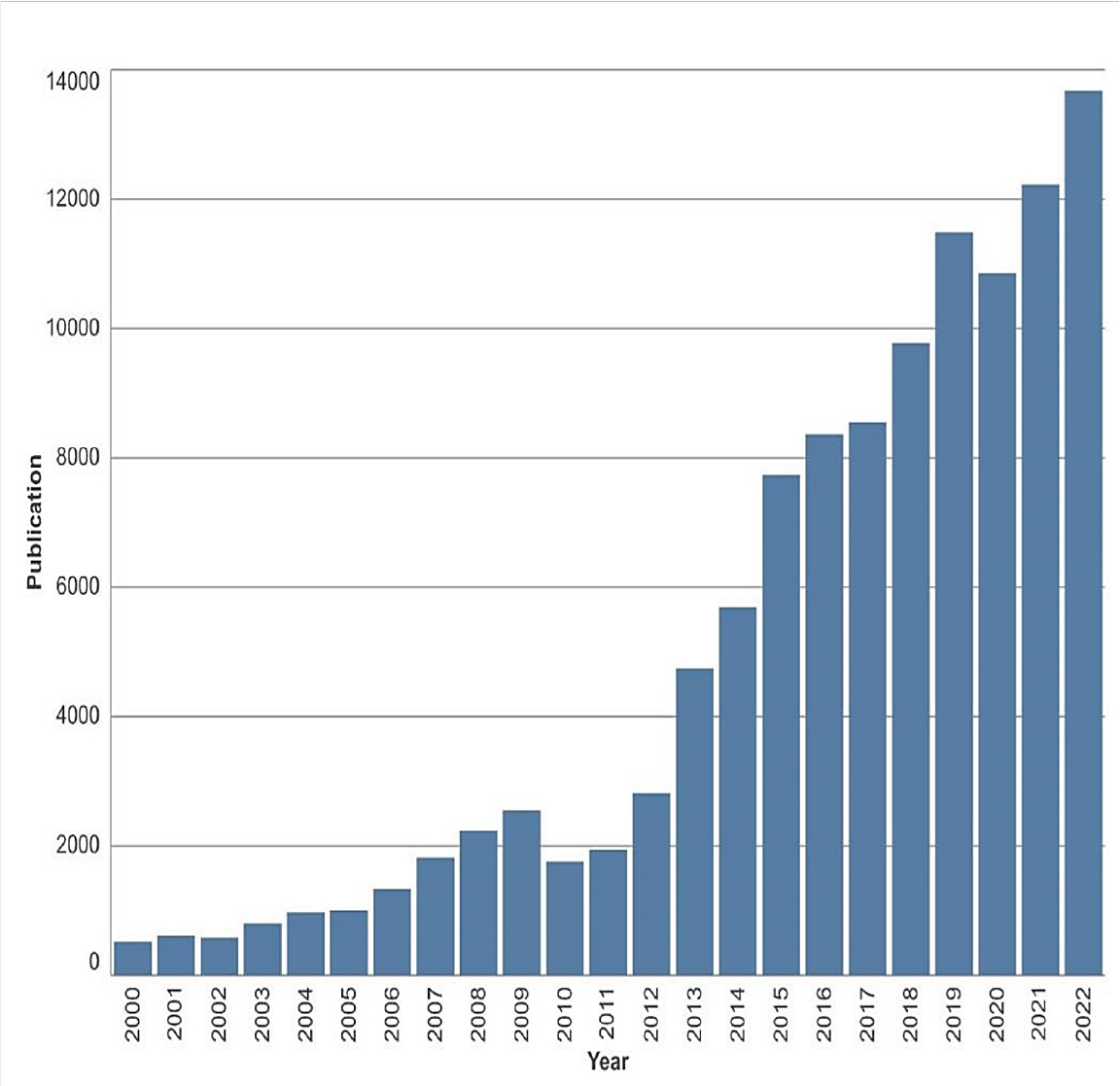
Figure 1:
Number of publications of MEA countries in computer science research by years.
Most of the publications by MEA countries are conference proceeding papers and journal articles, with nearly equal numbers of publications (refer to Table 1). Furthermore, a significant portion of the total number of publications (28,677 publications) are open access, comprising approximately 25% of the total publications.
| Document Type | Number of Publications | Percentage |
|---|---|---|
| Proceeding Paper | 56,478 | 50.34% |
| Article | 54,102 | 48.23% |
| Book Chapters | 1,801 | 1.61% |
| Review Article | 1,616 | 1.44% |
A treemap was generated to examine the research productivity of each MEA country during the period of study (refer to Figure 2). From the treemap, it can be observed that Saudi Arabia is the predominant contributor to computer science research in the MEA region. Saudi Arabia tops the chart with a total of 29,944 publications over the 23 years, constituting about 26% of the total publications from MEA countries. The contribution from Saudi Arabia is significant, as it has approximately 75% more publications than Egypt, which ranks second with 17,316 publications. Aside from Saudi Arabia and Egypt, Tunisia, the UAE, Algeria, and Morocco are some other significant contributors to computer science research in the MEA region.
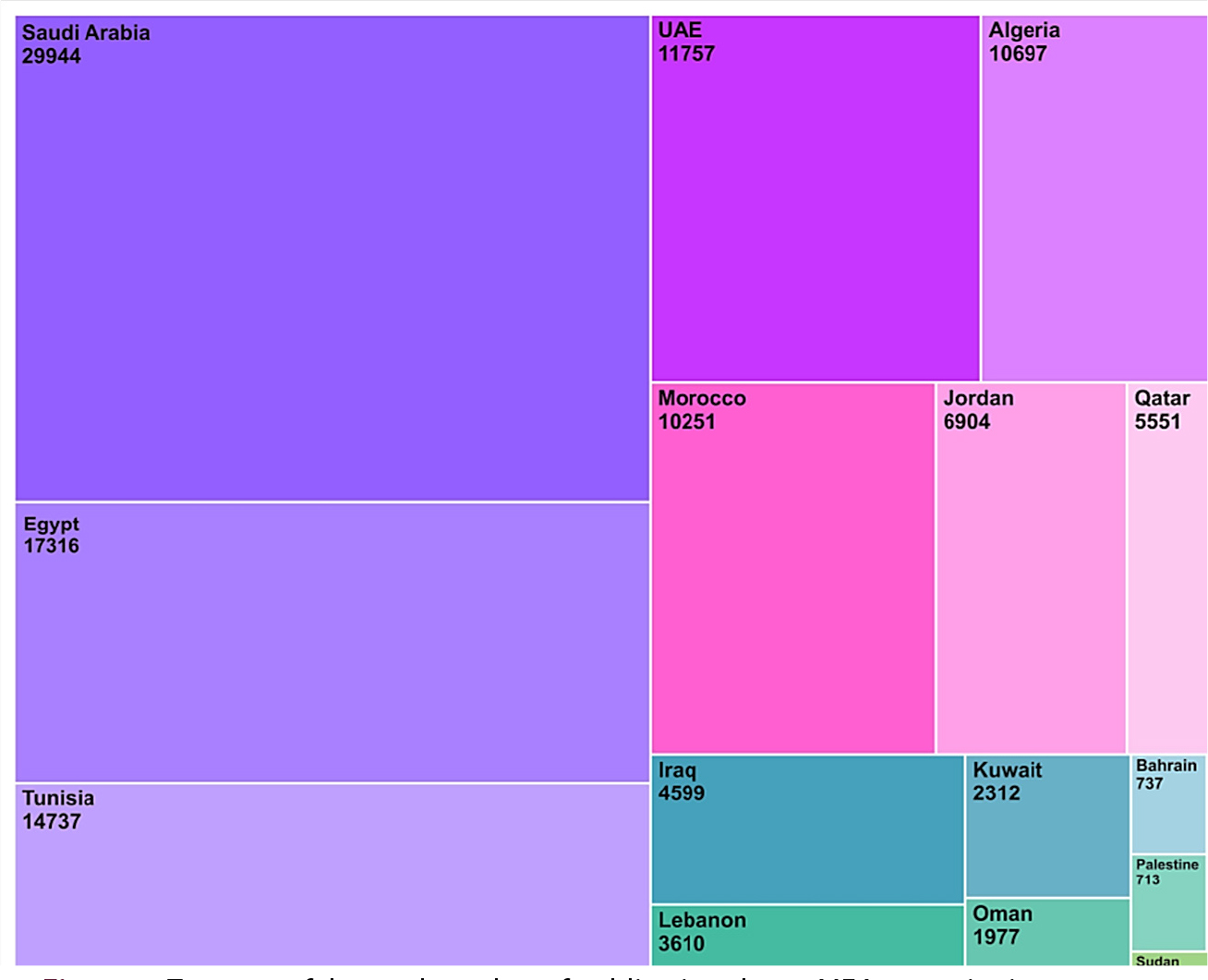
Figure 2:
Treemap of the total number of publications by 18 MEA countries in computer science research from 2000 to 2022. The numbers below the country names indicate the total number of publications for each country.
A breakdown of the number of publications by MEA countries over the years (refer to Figure 3) shows that Egypt was the leading contributor in the early 2000s, accounting for more than 25% of the total publications in the MEA region. However, starting in 2011, the number of publications from Saudi Arabia increased rapidly, outperforming Egypt to become the largest contributor to computer science research in the MEA region. Saudi Arabia has significantly expanded its academic research over the past two decades, establishing research universities, such as King Abdullah University of Science and Technology, that emphasize advanced research in technology and innovation. Aside from that, Saudi Arabia has governmental organizations that provide substantial amounts of research grants to encourage the development of various emerging and trending science and technology research projects. Tunisia was also a major contributor, peaking in 2009 with approximately 19% of the total publications that year. Surprisingly, the contribution of Tunisia to computer science research has declined since then, falling to around 7% of the total publications in 2022. Similarly, Algeria reached its peak contribution in 2008 with approximately 14% of the total publications, but this proportion decreased to around 5% by 2022. On the other hand, the UAE has maintained a consistent contribution of around 10% from 2000 to 2022. Contributions from Qatar and Iraq have been increasing steadily over the decades, reaching 4% and 6% respectively in 2022.

Figure 3:
Publication trend of MEA countries in computer science research from 2000 to 2022. “Others” encompasses MEA countries that are included in this study but are not individually shown in the plot.
RESEARCH AREAS OF MEA COUNTRIES IN COMPUTER SCIENCE
The analysis of research areas reveals a close association between computer science research in MEA countries and various research areas from 2000 to 2022, as depicted in Figure 4. Initially, computer science research was closely linked to engineering research. However, over the last decade, there has been a noticeable shift, with an increasing proportion of computer science publications associated with telecommunication research. By 2022, slightly more than 25% of computer science publications were related to telecommunication, compared to only 7% in 2000. Generally, associations with mathematics, autonomous control systems, and imaging science photographic technology have reduced over the years. This observation shows that MEA countries are gradually shifting from traditional research disciplines towards more industry-relevant research areas in the domain of computer science. This phenomenon suggests that computer science research in MEA countries is in line with the global trend in addressing challenges in digital transformation and IR4.0, such as the Internet of Things (IoT) and wireless technology.
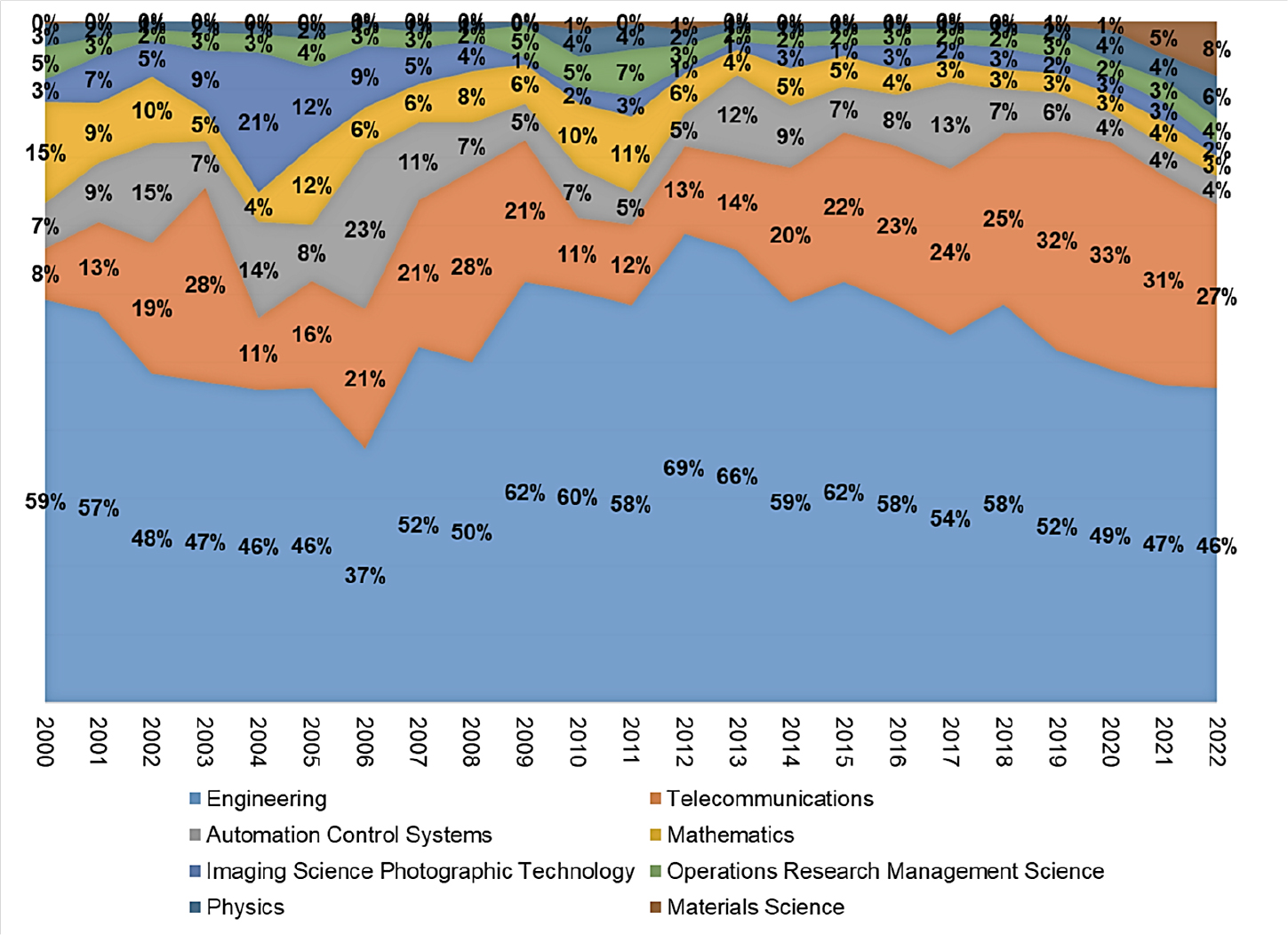
Figure 4:
Publication trend of Top 10 research areas associated with computer science research in MEA countries from year 2000 to 2022.
On the other hand, there has been a growing association with physics and material science in recent years. Notably, the association with material science has grown rapidly over the past two years, reaching 5% of the total publications in 2021 and 8% in 2022. The drastic increase is mainly due to the incorporation of machine learning and big data into material science research, which has enhanced the design, analysis, and discovery of new materials.
Figure 5 depicts the distribution of publications in computer science research in MEA countries across various research foci, as defined by the WoS categories. Generally, the proportion of different foci has remained consistent, despite some fluctuations over certain periods. For instance, the proportion of hardware architecture research has consistently ranged from 6% to 10% of the total publications over the years, showing significant increases only in 2003 and 2008. Furthermore, it can be observed that artificial intelligence was the prominent research focus in the early 2000s. Starting in 2009, theory methods research emerged as the most popular focus. Although information systems had already been a popular focus since the 2010s, it swiftly overtook theory methods research as the major focus in MEA computer science research. From 2017 onwards, the proportion of theory methods research decreased, while information systems research grew rapidly. The emergence of information systems as the predominant research focus in MEA countries supports the aforementioned observation of the increasing association between computer science and telecommunications research. Cybernetics has consistently remained a niche scope within computer science research in MEA countries.
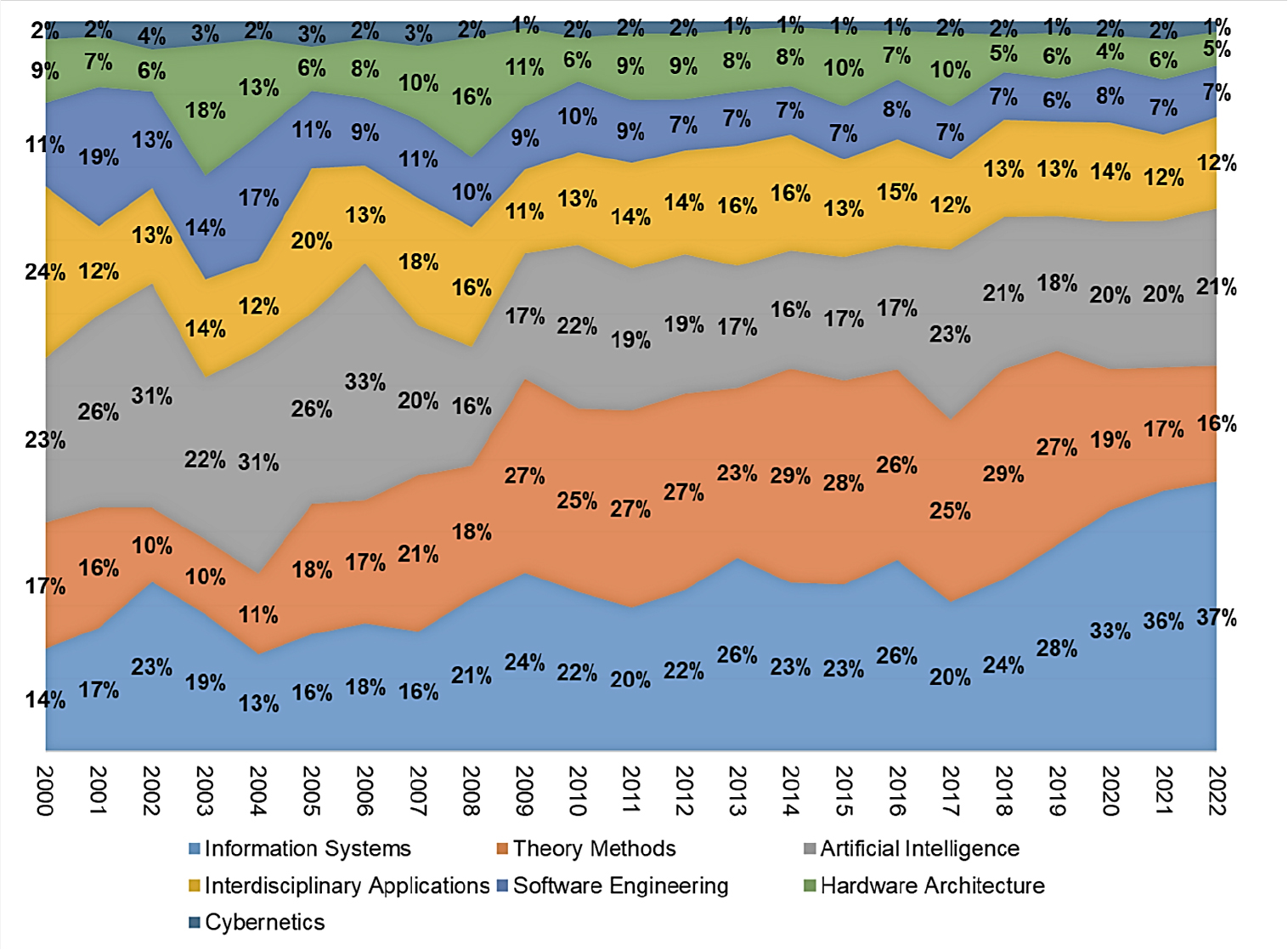
Figure 5:
Publication trends of research focus on computer science in MEA countries from 2000 to 2022.
EVOLUTION OF RESEARCH TOPICS IN COMPUTER SCIENCE RESEARCH IN MEA COUNTRIES
The analysis of the eigenvector centrality and community structure in the term co-occurrence networks provides insight into the evolution of research topics in computer science research within the MEA region.
The top 20 terms ranked by eigenvector centrality for each year were identified, and these terms were subsequently used to construct a timeline graph of important terms (refer to Figure 6). The graph provides an overview of the evolution of focus areas within the research landscape. As shown in Figure , the terms “Image” and “Feature” have consistently been regarded as one of the popular terms in computer science within MEA countries, maintaining their popularity since 2000. On the other hand, “Network,” “Technology”, and “Accuracy” have been important research topics for almost 20 years. Since 2005, there has been a notable diversification in research topics, with terms such as “Scheme,” “Database,” “Classification,” “Detection,” and “Security” gaining considerable attention in computer science research in MEA countries. More recently, from 2017 to 2022, “Optimization” has emerged as a popular research topic.
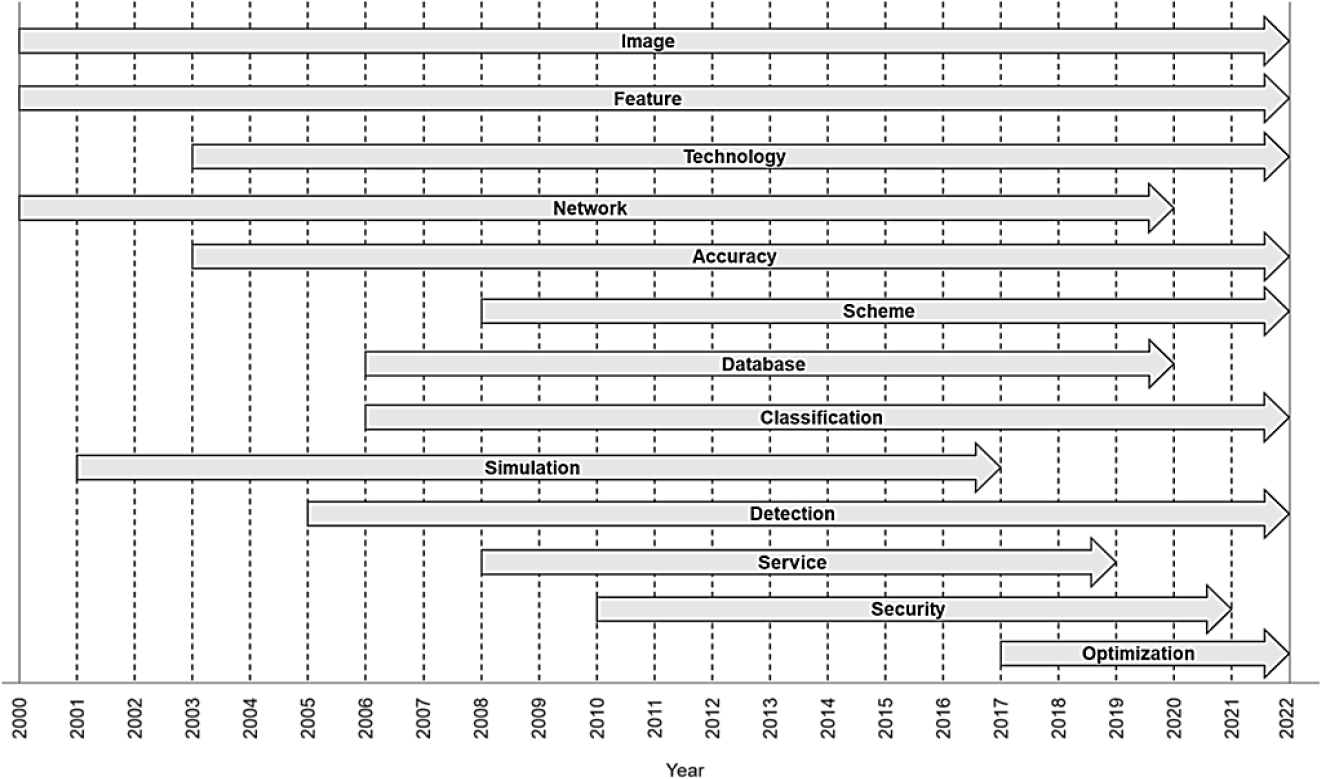
Figure 6:
Timeline of important terms in computer science research in MEA countries. Only terms that rank in the top 20 continuously for at least 5 years are included.
To further analyze the research trends and shifts of focus areas in computer science research in MEA countries, a modularity-based community detection method[32] was applied to the term co-occurrence networks from the last 10 years of the study period (2013 to 2022). Throughout this decade, image processing, network security, control systems, and technology services were persistent focus areas (refer to Table 2). Initially, research predominantly centered on image processing and signal classification, with terms such as “feature,” “detection,” “image,” “accuracy,” and “signal” frequently appearing among the top-ranked terms. This indicates a strong interest in developing advanced techniques for image and signal analysis. In the meantime, there was a significant emphasis on network security and communication protocols, as shown by the frequent occurrence of terms like “network,” “scheme,” “protocol,” “communication,” “security,” and “attack.” This suggests that safeguarding information and improving communication infrastructures were critical research priorities during this period.
| Terms Grouped by Cluster and Year |
|---|
| 2013 |
| 1. Feature, detection, image, accuracy, signal, classification. |
| 2. Network, scheme, protocol, communication, security, attack. |
| 3. Control, frequency, speed, robot, circuit. |
| 4. Technology, service, learning, cloud. |
| 2014 |
| 1. Control, robot, stability. |
| 2. Technology, service, architecture, security, attack, management. |
| 3. Feature, accuracy, image, classification, recognition. |
| 4. Network, scheme, communication, protocol, sensor, signal. |
| 2015 |
| 1. Control, simulation, frequency, speed. |
| 2. Feature, accuracy, detection, image, classification, signal. |
| 3. Network, scheme, communication, protocol, sensor. |
| 4. Service, attack, management, security, platform, cloud, internet. |
| 2016 |
| 1. Technology, service, device, management, security, platform, internet, cloud. |
| 2. Feature, detection, accuracy, image, classification, signal. |
| 3. Control, frequency, stability, dynamic, circuit, robot. |
| 4. Network, scheme, communication, protocol, simulation, attack, sensor. |
| 2017 |
| 1. Control, speed, stability. |
| 2. Network, scheme, device, communication, attack, protocol, simulation, sensor. |
| 3. Feature, accuracy, detection, image, classification, signal. |
| 4. Technology, service, research, internet, cloud, security. |
| 2018 |
| 1. Feature, accuracy, image, classification, database, region. |
| 2. Network, scheme, protocol, communication, attack, sensor, simulation, control, signal. |
| 3. Technology, service, device, internet, resource, management, security, cloud, IOT. |
| 2019 |
| 1. Network, scheme, communication, control, protocol, simulation, sensor. |
| 2. Feature, accuracy, detection, image, classification, signal, prediction. |
| 3. Technology, service, device, resource, internet, attack, security, management, IOT. |
| 2020 |
| 1. Feature, accuracy, detection, image, classification, prediction. |
| 2. Network, scheme, communication, simulation, control, sensor. |
| 3. Optimization, genetic algorithm, search, particle swarm optimization, convergence. |
| 4. Technology, service, internet, device, security, management, attack. |
| 2021 |
| 1. Feature, accuracy, detection, classification, image, prediction, machine learning. |
| 2. Technology, management, COVID, learning, industry. |
| 3. Optimization, genetic algorithm, convergence, particle swarm optimization. |
| 4. Internet, device, service, scheme, IOT, security, communication. |
| 2022 |
| 1. Accuracy, feature, detection, classification, machine learning, image, prediction, deep learning. |
| 2. Technology, internet, service, device, cost, security, scheme, IOT. |
| 3. Optimization, search, genetic algorithm, particle swarm optimization. |
| 4. World, review, survey, relationship, pandemic, health. |
In the mid-2010s, the focus of computer science research in MEA countries began to diversify. The emergence of terms such as “control,” “frequency,” “robot,” and “circuit” highlights an increasing interest in robotics and control systems. This trend demonstrates the growing attention to automation and robotics technologies in the region. By the late 2010s, more varied and complex topics emerged. For instance, the emergence of terms like “technology,” “service,” “cloud,” “internet,” and “IoT” indicates a booming interest in cloud computing and the Internet of Things. This shift emphasizes a broader global trend towards advancing interconnected devices and cloud services to propel technological innovation.
From 2020 onwards, there was a rise in research related to machine learning and optimization algorithms. Terms such as “machine learning,” “deep learning,” “prediction,” “genetic algorithm,” and “particle swarm optimization” became prominent, which reflects the increasing importance of artificial intelligence and optimization techniques in addressing complex computational problems.
COLLABORATION AMONG MEA COUNTRIES IN COMPUTER SCIENCE RESEARCH
Research collaborations among MEA countries during two distinct periods (Period 1: 2000 – 2012 and Period 2: 2013 – 2022) are visualized as connection maps in Figure 7. The timeline was divided into these two periods due to the drastic increase in the total number of publications observed in the last decade, starting in 2013 (refer to Figure ). It can be observed that collaborations between MEA countries in computer science research were significantly more active in Period 2, with 17 MEA countries involved in regional research collaborations, compared to only 8 MEA countries in Period 1. Saudi Arabia, Egypt, and the UAE remain the top three MEA countries that contributed the most in facilitating research collaborations within the MEA region throughout the two periods.
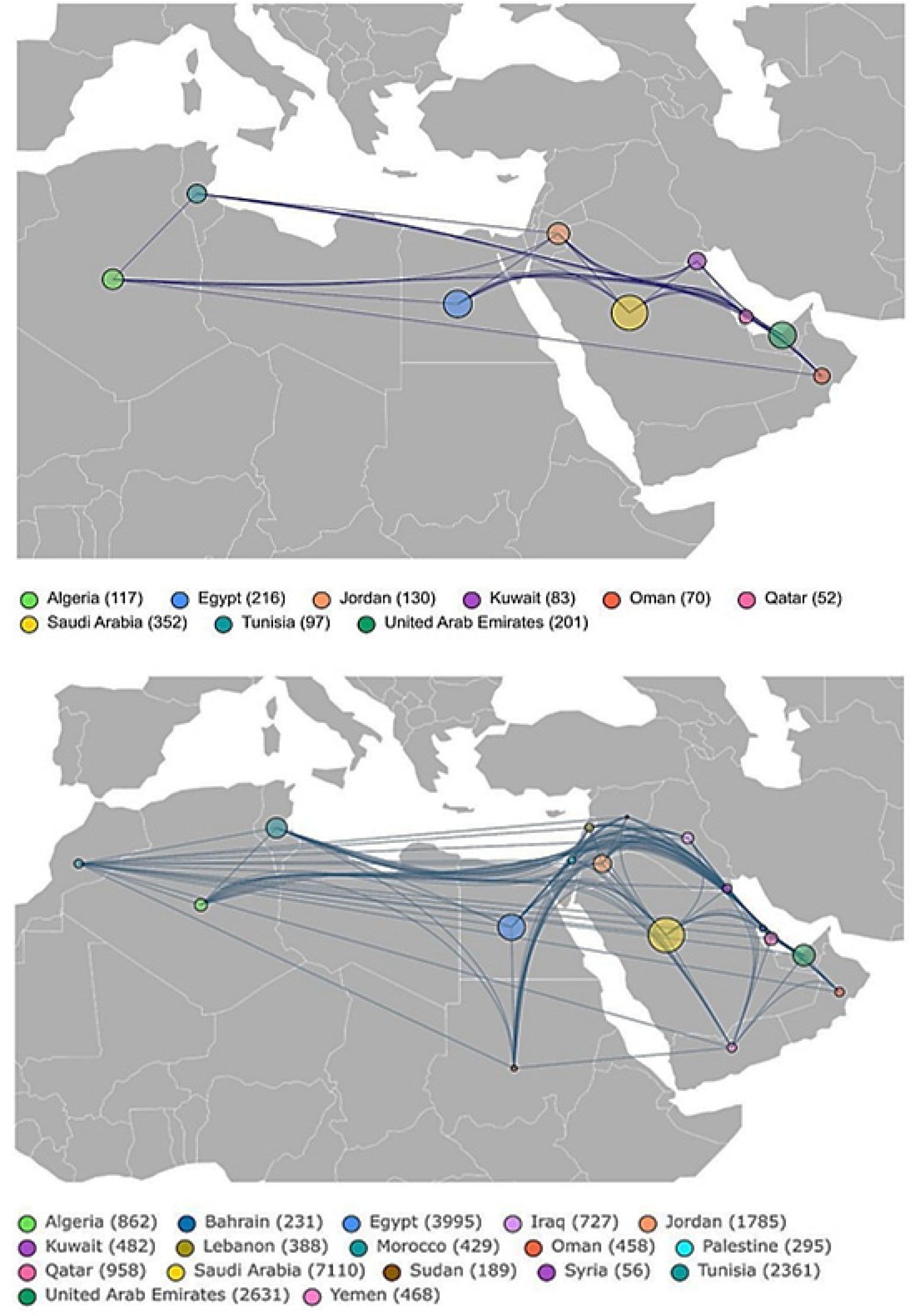
Figure 7:
Connection map of research collaborations among MEA countries in computer science: (Top) 2000–2012, (Bottom) 2013 – 2022. The numbers in brackets in the legend indicate the average weighted degree. Node size reflects the average weighted degree. Countries with a degree less than 50 are excluded.
During Period 2, Bahrain, Iraq, Lebanon, Morocco, Palestine, Sudan, Syria, and Yemen began to expand their research collaborations with other MEA countries. Tunisia was significantly more active in regional research collaborations during Period 2, with approximately 20% of its publications involving collaborations with other MEA countries (refer to Table 3). There was an overall increase in the frequency of regional research collaborations from Period 1 to Period 2, indicating a growing trend of cooperative research efforts within the MEA region in computer science research. The active participation of countries in regional collaborations helps to build strong research networks across the MEA region, which facilitates the sharing of knowledge and resources. Eventually, it will contribute to the overall improvement of the research environment. Regional collaborative efforts can lead to higher research output and quality in a region, as highlighted in the papers by De Noni et al.[33]
| Period 1 (2000-2012) | Period 2 (2013-2022) | ||||
|---|---|---|---|---|---|
| Country | TP | Percentage | Country | TP | Percentage |
| Algeria | 2250 | 5.20% | Algeria | 8447 | 10.20% |
| Bahrain | 579 | 39.90% | |||
| Egypt | 3899 | 5.54% | Egypt | 13417 | 29.78% |
| Iraq | 4360 | 16.67% | |||
| Jordan | 1388 | 9.37% | Jordan | 5516 | 32.36% |
| Kuwait | 793 | 10.47% | Kuwait | 1519 | 31.73% |
| Lebanon | 2605 | 14.89% | |||
| Morocco | 9133 | 4.70% | |||
| Oman | 491 | 14.26% | Oman | 1486 | 30.82% |
| Palestine | 693 | 42.57% | |||
| Qatar | 389 | 13.37% | Qatar | 5162 | 18.56% |
| Saudi Arabia | 2846 | 12.37% | Saudi Arabia | 27098 | 26.24% |
| Sudan | 617 | 30.63% | |||
| Syria | 243 | 23.05% | |||
| Tunisia | 11977 | 19.71% | |||
| UAE | 1973 | 10.19% | UAE | 9784 | 26.89% |
| Yemen | 684 | 68.42% | |||
International collaboration of Mea Countries in Computer Science Research
First and foremost, it is important to clarify that “international research collaborations” in this context refer to the collaborative research endeavors between MEA countries and non-MEA countries. Various studies have shown that international research collaborations have a positive impact on the productivity, quality, and visibility of research outputs.[34–36]
It is depicted in Figure 8 that MEA countries have established extensive international research collaborations in computer science with nations across all regions of the world. These collaborations are particularly frequent with countries that are highly active in computer science research, such as China, India, the USA, the United Kingdom, France, and Canada.
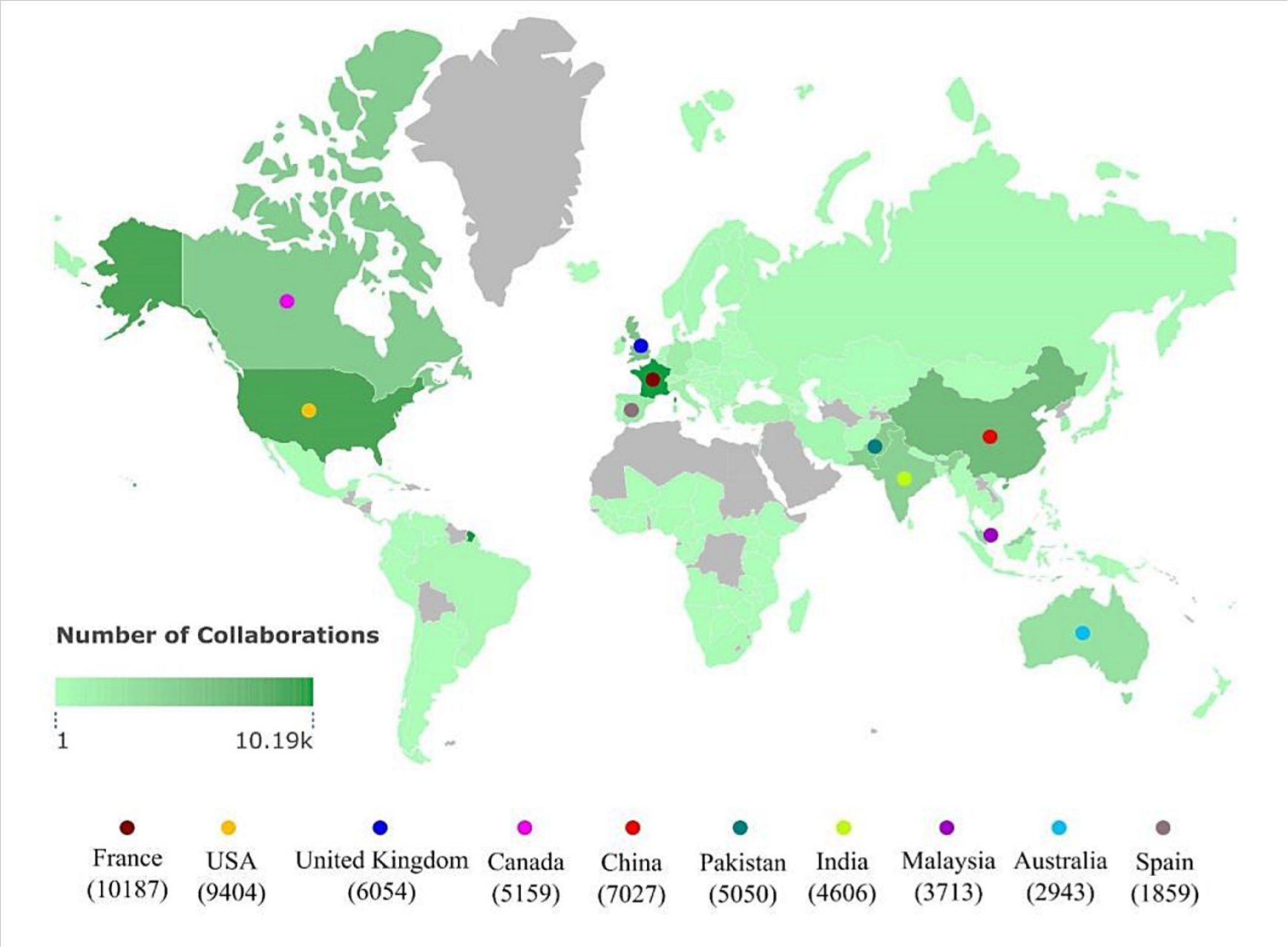
Figure 8:
Distribution of international research collaboration by MEA countries in computer science (2000 – 2022). The top 10 collaborating countries are highlighted with the number of collaborations in brackets. MEA countries and non-collaborating countries are greyed out.
Table 4 illustrates the primary non-MEA countries that collaborated with each MEA country from 2000 to 2022. Most MEA countries frequently collaborated with the USA, China, and the United Kingdom in computer science research. These countries are global leaders in computer science research. Collaboration with these countries allows researchers from the MEA region to access state-of-the-art technology and knowledge in computer science, hence significantly improving the quality of their research. Algeria, Lebanon, Morocco, and Tunisia have a high frequency of research collaborations with France due to their historical ties with France. On the other hand, Malaysia provides appealing research funding opportunities and scholarships, including the High Impact Research initiative initiated by the University of Malaya in 2021, which has attracted both national and international research talents to engage in high-quality research endeavors. MEA countries with strong diplomatic relations with Malaysia, such as Yemen, Bahrain, and Iraq, have subsequently established research collaborative partnerships with Malaysia.
| MEA Country | Main Non-MEA Research Collaborators | ||
|---|---|---|---|
| 1st | 2nd | 3rd | |
| Algeria | France (27%) | Canada (3%) | United Kingdom (3%) |
| Bahrain | Malaysia (8%) | Pakistan (7%) | India (6%) |
| Egypt | USA (8%) | China (5%) | Canada (4%) |
| Iraq | Malaysia (18%) | United Kingdom (13%) | India (7%) |
| Jordan | USA (11%) | United Kingdom (7%) | Malaysia (5%) |
| Kuwait | USA (12%) | Canada (7%) | United Kingdom (5%) |
| Lebanon | France (26%) | USA (10%) | Canada (9%) |
| Libya | United Kingdom (17%) | Malaysia (10%) | Canada (7%) |
| Morocco | France (13%) | Spain (3%) | Canada (2%) |
| Oman | India (12%) | United Kingdom (12%) | Malaysia (8%) |
| Palestine | Malaysia (9%) | China (7%) | Germany (6%) |
| Qatar | USA (25%) | China (19%) | United Kingdom (9%) |
| Saudi Arabia | Pakistan (12%) | China (11%) | USA (10%) |
| Sudan | Malaysia (18%) | China (11%) | USA (6%) |
| Syria | India (17%) | France (9%) | Italy (8%) |
| Tunisia | France (25%) | Canada (3%) | USA (2%) |
| UAE | USA (14%) | Canada (9%) | China (9%) |
| Yemen | Malaysia (37%) | India (9%) | China (8%) |
The trend of international collaboration of MEA countries in computer science research can be examined through the internationality scores over a period of time. Figure 9 shows the internationality scores of the top 9 MEA countries with the highest number of publications from 2013 to 2022. The data indicates an upward trend in internationality scores for most of the selected MEA countries, except for Iraq, which shows a downward trend, and Morocco, whose internationality score remains relatively stable at around 0.27. This pattern indicates that over the past decade, most of the highly productive MEA countries have increasingly sought to expand their research connections and establish collaborations outside the MEA region. Notably, Egypt and the UAE have exhibited the most rapid growth in terms of international collaborations over the last decade.
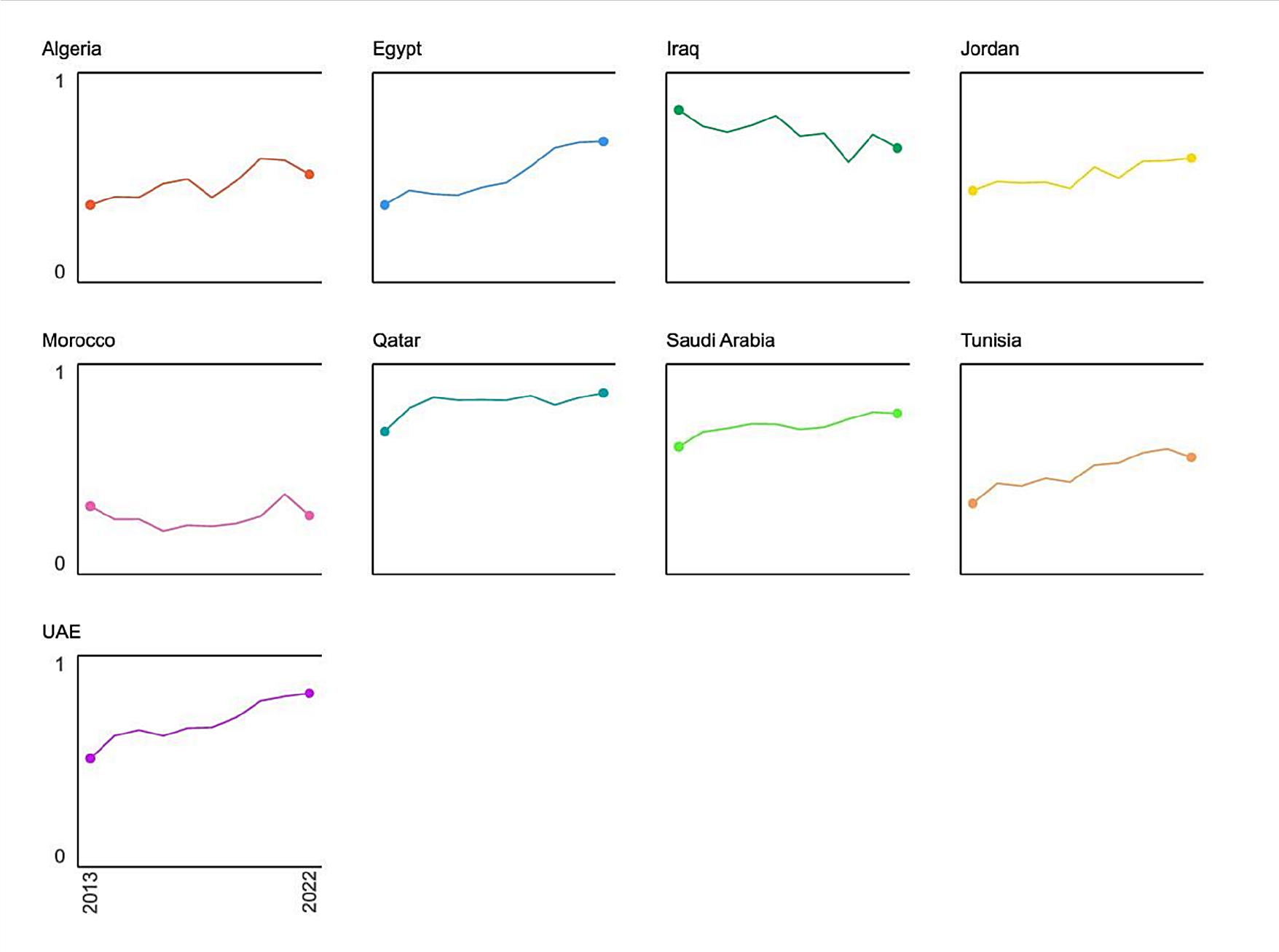
Figure 9:
The internationality scores of 9 MEA countries from 2013 to 2022.
Further analysis of the average internationality scores over a 10-year period (refer to Table 5) shows that MEA countries generally maintained an average internationality score of more than 0.5 over the past decade (2013 – 2022), except for Tunisia (0.49), Algeria (0.47), and Morocco (0.27). This indicates that over 50% of the computer science research publications produced by MEA countries were the result of international research collaborations. The overall average internationality score for MEA countries is approximately 0.64. Yemen, Qatar, and Sudan have been the most active in establishing international collaborations, with their average internationality scores of approximately 42%, 28%, and 22% higher than the overall average score, respectively.
| MEA Country | Average Internationality Scores over 10 years (2013-2022) |
|---|---|
| Algeria | 0.47 |
| Bahrain | 0.64 |
| Egypt | 0.51 |
| Iraq | 0.72 |
| Jordan | 0.51 |
| Kuwait | 0.60 |
| Lebanon | 0.63 |
| Libya | 0.71 |
| Morocco | 0.27 |
| Oman | 0.71 |
| Palestine | 0.61 |
| Qatar | 0.82 |
| Saudi Arabia | 0.71 |
| Sudan | 0.77 |
| Syria | 0.70 |
| Tunisia | 0.49 |
| UAE | 0.68 |
| Yemen | 0.90 |
Research Collaboration Networks Of Computer Science Research in Mea Countries
In general, the number of nodes and network density of collaboration networks in computer science research within the MEA region increased from 2000 to 2022, despite occasional fluctuations in network density at specific years (refer to Figure 10). The rising number of nodes highlights the increase of participating countries, indicating a broader inclusion countries in collaborative research efforts. On the other hand, the increase in network density shows that most of the MEA countries are forming collaborations with a wider array countries over the years, rather than simply focusing on strengthening existing collaborations.
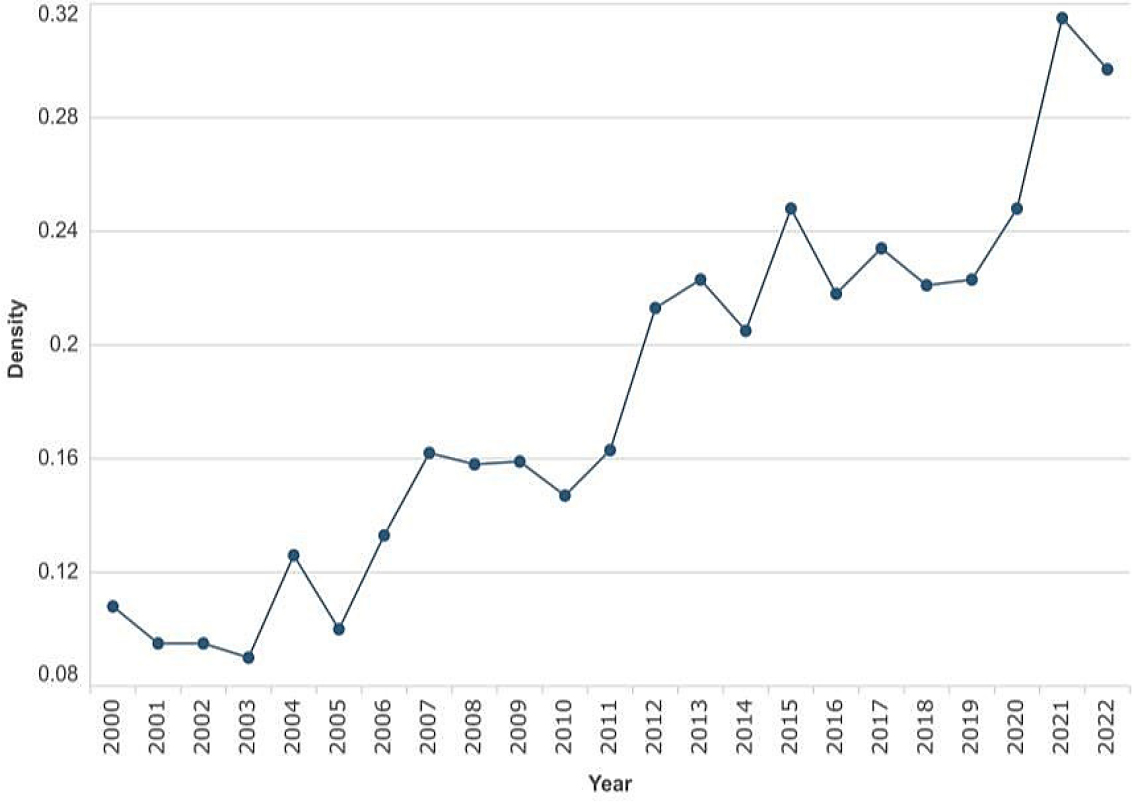
Figure 10:
The network density of research collaboration networks from 2000 to 2022.
Figure 11 depicts notable structural changes in the collaboration networks, shown by a steady increase in the average clustering coefficient and a gradual decrease in the average path length over the years. The rise in the average clustering coefficient demonstrated a growing tendency for MEA countries to form cohesive research groups, both within the region and with international collaborators. Meanwhile, the decreasing path length indicates reduced fragmentation, as MEA countries diversify their partnerships while expanding their collaborative networks over the years. These changes suggest the intensification of the smallworld phenomenon in research collaborations within the region, which enhances knowledge dissemination. These findings highlight the efforts of MEA region to promote healthy research collaboration dynamics and become a more cohesive and impactful contributor to global computer science research.

Figure 11:
The average clustering coefficient and average path length of research collaboration networks from 2000 to 2022.
From Figure 12, it can be observed that the degree centralization of the networks increases marginally over the years. This indicates the emergence of some countries as central hubs for research collaboration in computer science research within the MEA region. Research collaboration central hubs are important as they serve as the main countries that directly or indirectly connect most of the MEA and non-MEA countries through collaborations. Upon further investigation of the top MEA countries in terms of weighted degree in the networks, it can be observed that Saudi Arabia, the UAE, Egypt, and Tunisia served as the central hubs of research collaboration in the MEA region throughout the years. Algeria was in the top five until 2013, after which Qatar overtook Algeria in 2014, only to be surpassed by Jordan in the last two years. These MEA countries also possess strong research institutions (refer to Table 6) with well-established funding programs, enabling them to actively promote and invest in international research collaborations.
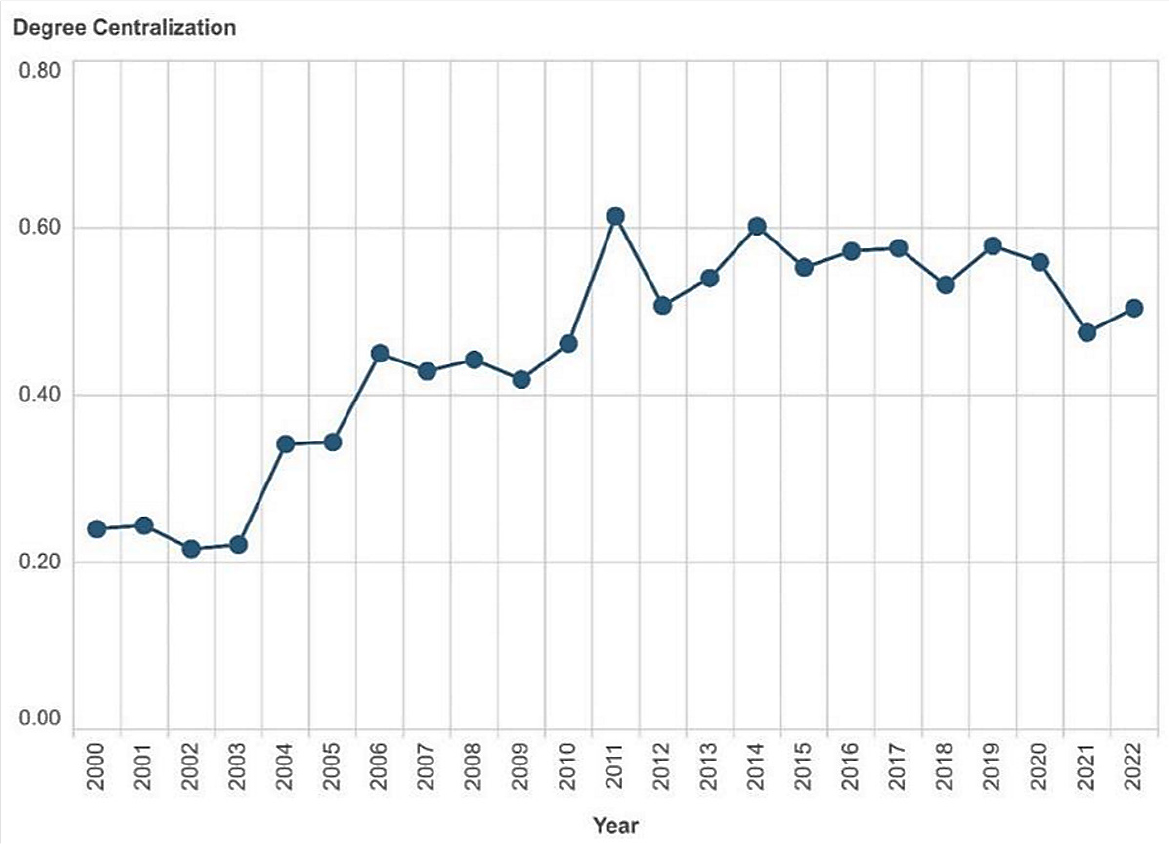
Figure 12:
The degree and eigenvector centralizations of research collaboration networks from 2000 to 2022.
| Institution | Country | Number of Publications |
|---|---|---|
| King Saud University | Saudi Arabia | 5175 |
| Université de Sfax | Tunisia | 4665 |
| Cairo University | Egypt | 3131 |
| Qatar Foundation | Qatar | 2934 |
| Khalifa University of Science and Technology | UAE | 2195 |
| University of Science and Technology Houari Boumediene | Algeria | 1631 |
| Jordan University of Science and Technology | Jordan | 1473 |
REGIONAL STRATEGIES AND NATIONAL INITIATIVES AS DRIVER OF RESEARCH DEVELOPMENT
The rapid growth of computer science research in the MEA region has been significantly driven by the launching of various regional and national initiatives and policies. These initiatives have played an important role in developing and shaping the research landscape by providing funding to research institutions and universities. This financial support has not only enhanced the quantity and quality of research projects but also encouraged regional and international research collaborations. Such collaborations have exposed MEA countries to the frontier in computer science outside the region, causing a strategic shift in their research focus to align with global trends. These efforts have collectively strengthened the region’s position in the global scientific community.
On the regional scale, the Strategy for the Development of Science and Technology in the Arab World has provided a strong foundation for fostering research and innovation in the region. This framework is further reinforced by the Arab Digital Economy Strategy, which emphasizes the importance of digital transformation. These regional cooperation efforts highlight a coordinated approach to enhancing research output, driving technological progress, and supporting sustainable development.[37]
The Arab Strategy for Science, Technology, and Innovation, established in 2014 by the Council of Ministers of Higher Education and Scientific Research in the Arab World, serves as a comprehensive framework to drive scientific and technological progress across Arab nations. This strategy seeks to foster regional academic collaboration, strengthen connections between academia and industry, and encourage investments in technology-driven sectors. Priority areas include renewable energy, water security, biotechnology, and information technology.[38]
At the national level, the UAE stands out with initiatives such as the Mohammed bin Rashid Space Centre, which oversees major projects like the Emirates Mars Mission (Hope Probe). Furthermore, the UAE National Innovation Strategy (launched 2014) aims at achieving global leadership in sectors such as renewable energy and transportation. Saudi Arabia Vision 2030 (launched 2016) emphasizes technological investment to diversify the economy, supported by contributions from the King Abdulaziz City for Science and Technology (KACST). Similarly, Qatar National Research Strategy (launched 2008) and the Qatar Science & Technology Park (launched 2009) focus on fostering innovation in key areas such as energy, health, and computing, underscoring the nation’s commitment to advancing research and development. Egypt Vision 2030 (launched 2016) creates an environment that nurtures technological advancements, including investment in innovative technology research projects and promoting international collaborations.[39,40]
CONCLUSION
This study explores the growth and development of computer science research across 22 MEA countries from 2000 to 2022. Utilizing bibliometric and complex network analysis, the research examines productivity, trends, and collaborations within the field. Findings indicate a significant increase in publications since 2013, with Saudi Arabia contributing approximately a quarter of the total output, positioning it as the leading contributor in the region. Over time, research associations have shifted from a focus on engineering and telecommunications to encompass physics and material science, indicating a broader interdisciplinary approach. Key research areas throughout the period included information systems, artificial intelligence, and theoretical methods, while cybernetics remained a niche field. Analyzing the co-occurrence networks from 2013 to 2022 reveals an expansion of research into emerging domains such as robotics, cloud computing, the Internet of Things (IoT), and artificial intelligence, highlighting the region’s alignment with contemporary technological advancements. Regional strategies, such as the Arab Strategy for Science, Technology, and Innovation, drive the focus on research areas that align with the latest trends and proactively embrace cuttingedge technologies, particularly in the context of the Fourth Industrial Revolution (IR 4.0). National initiatives, including the UAE National Innovation Strategy, Saudi Arabia Vision 2030, Qatar National Research Strategy, and Egypt Vision 2030, have provided substantial funding to support research in science and technology, including computer science, since their establishment. The rapid growth in research productivity in the UAE, Saudi Arabia, Egypt, and Qatar highlights the significant role these national initiatives play in advancing computer science research in these countries
Despite the rapid growth in the research landscape of the MEA region over the past decades, there remains a long path ahead for the region to become a global hub for computer science research, as its total publications from 2000 to 2022 account for only 3% of the global total. However, the future of computer science research in the MEA region appears promising, with numerous transformative initiatives underway. Universities and research institutions are central to this transformation, with a significant increase in the establishment of new institutions over the years. The rising trend in regional and international collaborations in the MEA region shows that the region is adopting the right strategies to advance computer science research. To build on this momentum, the region should further promote these collaborations by providing more platforms for research exchange. Furthermore, there is potential for further progress in areas such as cybersecurity, especially with the region’s increasing emphasis on blockchain and digital currency. Another promising frontier is the development of networks and IoT, which are essential to the development of smart cities.
Cite this article:
Chin JH,Dharhani GSA, Ratnavelu K. Evolution of Computer Science Research in Middle East and Africa Countries: A Two Decade Overview of Research Development and Trends. J Scientometric Res. 2025;14(2):587-604.
References
- Al-Khalifa HS.. Scientometric assessment of Saudi publication productivity in computer science in the period of 1978-2012.. Int J Web Inf Syst.. 2014;10(2):194-208. [CrossRef] | [Google Scholar]
- Gul S, Nisa NT, Shah TA, Gupta S, Jan A, Ahmad S., et al. Middle East: research productivity and performance across nations.. Scientometrics.. 2015;105(2):1157-66. [CrossRef] | [Google Scholar]
- Cavacini A.. Recent trends in Middle Eastern scientific production.. Scientometrics.. 2016;109(1):423-32. [CrossRef] | [Google Scholar]
- Djeflat A.. Sciences, technology, and social inequality in the Arab world: an analysis from the Maghreb.. Sociol Islam.. 2020;8(2):199-224. [CrossRef] | [Google Scholar]
- Zyoud SH.. The Arab region’s contribution to global COVID-19 research: bibliometric and visualization analysis.. Global Health.. 2021;17(1):31. [PubMed] | [CrossRef] | [Google Scholar]
- [Jul 7 2024];Research and innovation overall rankings – computer science; 2024 [Internet].. Middle East.. [PubMed] | [CrossRef] | [Google Scholar]
- Goodman SE, Green JD.. Computing in the Middle East.. Commun ACM.. 1992;35(8):21-4. [CrossRef] | [Google Scholar]
- El-Ouahi J, Robinson-García N, Costas R.. Analyzing scientific mobility and collaboration in the Middle East and North Africa.. Quant Sci Stud.. 2021;2(3):1-25. [CrossRef] | [Google Scholar]
- Ahmad S, Ur Rehman S, Ashiq M.. A bibliometric review of Arab world research from 1980-2020.. Sci Technol Libr.. 2021;40(2):133-53. [CrossRef] | [Google Scholar]
- Zeinoun P, Akl EA, Maalouf FT, Meho LI.. The Arab region’s contribution to global mental health research (2009-2018): A bibliometric analysis.. Front Psychiatry.. 2020;11:182. [PubMed] | [CrossRef] | [Google Scholar]
- Hassan Al Marzouqi AH, Alameddine M, Sharif A, Alsheikh-Ali AA.. Research productivity in the United Arab Emirates: A 20-year bibliometric analysis.. Heliyon.. 2019;5(12) [CrossRef] | [Google Scholar]
- Rhassate I, Amrous N, Bennani S.. The scientific production of the Moroccan researchers in computer science from 2007 to 2016: analysis and assessment.. Int J Recent Contrib Eng Sci IT.. 2018;6(4):49-64. [CrossRef] | [Google Scholar]
- Joseph PM, Lunt BM.. In: Proceedings of the 7th conference on information technology education.. 2006:25-30. [CrossRef] | [Google Scholar]
- [Jan 5 2024];Information technology (IT) in the Middle East [Internet];. 2023 [CrossRef] | [Google Scholar]
- Durugbo CM, Al-Jayyousi OR, Almahamid SM.. Wisdom from Arabian creatives: systematic review of innovation management literature for the Gulf Cooperation Council (GCC) Region.. Int J Innov Technol Manag.. 2020;17(6):2030004. [CrossRef] | [Google Scholar]
- Waqas A, Mehmood S, Jawwad AM, Pittam B, Kundu S, Correia JC, et al. Telemedicine in Arab countries: innovation, research trends, and way forward.. Front Digit Health.. 2020;2:610837. [PubMed] | [CrossRef] | [Google Scholar]
- Mrad F, Hanafi S, Arvanitis R.. Array. 2013 [PubMed] | [CrossRef] | [Google Scholar]
- [Jan 5 2024];Inception Institute of Artificial Intelligence [Internet]. Jobs.ac.Uk. [PubMed] | [CrossRef] | [Google Scholar]
- Yannis S.. [Jan 5 2024];Science, technology and security in the Middle East [Internet];. Einternational Relations. 2013 [PubMed] | [CrossRef] | [Google Scholar]
- Yacoub S, Villaborta LO.. [Jan 5 2024];Published on Arab Voices Bringing an Arabicized computer science education to the MENA region [Internet]. World Bank blogs Arab, editor.. Voices.. 2021 [PubMed] | [CrossRef] | [Google Scholar]
- Lozano S, Calzada-Infante L, Adenso-Díaz B, García S.. Complex network analysis of keywords co-occurrence in the recent efficiency analysis literature.. Scientometrics.. 2019;120(2):609-29. [CrossRef] | [Google Scholar]
- Siccardi S, Villa V.. Trends in adopting BIM, IoT and DT for facility management: A scientometric analysis and keyword co-occurrence network review.. Buildings.. 2022;13(1):15. [CrossRef] | [Google Scholar]
- Santos BS, Silva I, Costa DG.. Symmetry in scientific collaboration networks: A study using temporal graph data science and scientometrics.. Symmetry.. 2023;15(3):601. [CrossRef] | [Google Scholar]
- Raza SA, Govindaluri SM, Bhutta MK.. Research themes in machine learning applications in supply chain management using bibliometric analysis tools [international journal].. BIJ.. 2023;30(3):834-67. [CrossRef] | [Google Scholar]
- Tang KY, Chang CY, Hwang GJ.. Trends in artificial intelligence-supported e-learning: A systematic review and co-citation network analysis (1998-2019).. Interact Learn Environ.. 2023;31(4):2134-52. [CrossRef] | [Google Scholar]
- Wasserman S, Faust K.. Social network analysis: methods and applications.. 1994 [CrossRef] | [Google Scholar]
- Watts DJ, Strogatz SH.. Collective dynamics of ‘small-world’ networks.. Nature.. 1998;393(6684):440-2. [PubMed] | [CrossRef] | [Google Scholar]
- Freeman LC.. Centrality in social networks: conceptual clarification.. Soc Netw.. 1978;1(3):215-39. [CrossRef] | [Google Scholar]
- Newman ME.. The mathematics of networks.. The new Palgrave encyclopedia of economics.. Array;2:1-2. [CrossRef] | [Google Scholar]
- Glänzel W, Schubert A.. Domesticity and internationality in co-authorship, references and citations.. Scientometrics.. 2005;65(3):323-42. [CrossRef] | [Google Scholar]
- Van Eck NJ, Waltman L.. Software survey: VOSviewer, a computer program for bibliometric mapping.. Scientometrics.. 2010;84(2):523-38. [PubMed] | [CrossRef] | [Google Scholar]
- Waltman L, Van Eck NJ.. A smart local moving algorithm for large-scale modularitybased community detection.. Eur Phys J B.. 2013;86:1-4. [PubMed] | [CrossRef] | [Google Scholar]
- De Noni I, Ganzaroli A, Orsi L.. The impact of intra- and inter-regional knowledge collaboration and technological variety on the knowledge productivity of European regions.. Technol Forecasting Soc Change.. 2017;117:108-18. [CrossRef] | [Google Scholar]
- Wagner CS, Leydesdorff L.. Network structure, self-organization, and the growth of international collaboration in science.. Res Policy.. 2005;34(10):1608-18. [CrossRef] | [Google Scholar]
- Jones BF, Wuchty S, Uzzi B.. Multi-university research teams: shifting impact, geography, and stratification in science.. Science.. 2008;322(5905):1259-62. [PubMed] | [CrossRef] | [Google Scholar]
- Adams J.. Collaborations: The fourth age of research.. Nature.. 2013;497(7451):557-60. [PubMed] | [CrossRef] | [Google Scholar]
- Idlebi N Array. Innovation and Technology for Sustainable Development Promising prospects in the Arab region for 2030. [PubMed] | [CrossRef] | [Google Scholar]
- Dardas LA, Malkawi AM, Sweis S, Sweis N, Al-Khayat A, Sawair FA., et al. Mapping two decades of research productivity in the Middle Eastern and Arab countries: A comprehensive bibliometric analysis.. Publications.. 2023;11(4):48. [CrossRef] | [Google Scholar]
- Faghih N, Sarfaraz L.. Dynamics of innovation in Qatar and its transition to knowledgebased economy: relative strengths and weaknesses.. QScience Conn.. 2014;2014(1):23. [CrossRef] | [Google Scholar]
- Weber AS. In: Education for a knowledge society in Arabian Gulf countries. 2014;24:59-82. [CrossRef] | [Google Scholar]

